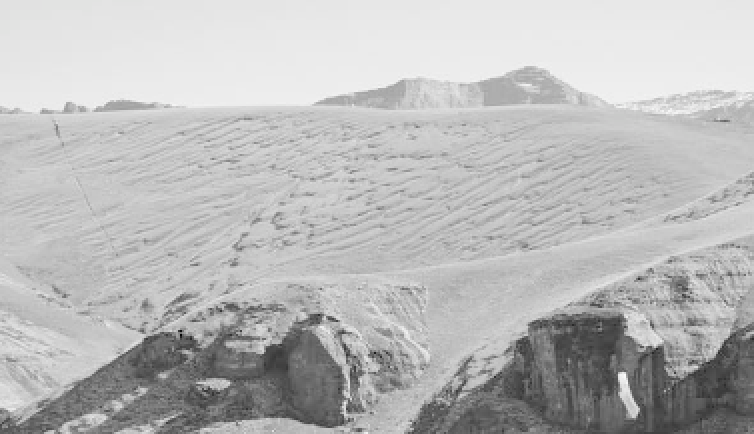Geology Reference
In-Depth Information
Plate 11.6
Solifluction lobes, Drakensberg, South Africa.
(
Photograph by Stefan Grab
)
Antarctica and in the unglaciated northern Yukon,
Canada. Type 3 comprises frost-shattered and gelifluc-
tion debris with moderately smooth,
concavo-convex
profiles
(Figure 11.6c). Residual hillside tors may project
through the debris on the upper valley sides. Such
profiles are often identified as relict periglacial forms dat-
ing from the Pleistocene, but they are not widely reported
from present-day periglacial regions. Type 4 profiles are
formed of gently sloping
cryoplanation terraces
(also
called 'goletz' terraces, altiplanation terraces, nivation
terraces, and equiplanation terraces) in the middle and
upper portions of some slopes that are cut into bedrock
on hill summits or upper hillslopes (Figure 11.6d). Cry-
oplanation terraces range from 10 m to 2 km across and
up to 10 km in length. The risers between the terraces
may be 70 m high and slope at angles of 30
◦
or more
where covered with debris or perpendicularly where cut
into bedrock. Cryoplanation terraces occur chiefly in
unglaciated northern Yukon and Alaska, and in Siberia.
They are attributed to nivation and scarp recession
through gelifluction (e.g. Nelson 1998), but substantive
field research into their formation is very limited (see
Thorn and Hall 2002). Type 5 profiles are rectilinear
cryopediments
, which are very gently concave erosional
surfaces that are usually cut into the base of valley-side or
mountain slopes, and are common in very dry periglacial
regions (Figure 11.6e). Unless they cut across geological
structures, they are difficult to distinguish from struc-
tural benches. Lithological and structural controls are
important in their development, which occurs in much
the same way as cryoplanation terraces except that slope
wash, rather than gelifluction, is more active in aiding
scarp recession. The processes involved in their forma-
tion appear to be bedrock weathering by frost action
combined with gravity-controlled cliff retreat and slope
replacement from below. In profile types 3 and 4, resid-
ual hilltop or summit tors surrounded by gentler slopes
are common on the interfluves. Many authorities argue
that periglacial slopes evolve to become smoother and
flatter, as erosion is concentrated on the higher section
and deposition on the lower section.
HUMANS AND PERIGLACIAL
ENVIRONMENTS
Attempts to develop periglacial regions face unique and
difficult problems associated with building on an icy sub-
strate (Box 11.3). Undeterred, humans have exploited
tundra landscapes for 150 years or more, with severe
disturbances occurring after the Second World War
with the exploration for petroleum and other resource

